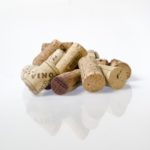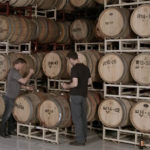Wino korkowe i inne wady wina

Najczęstszą spotykaną wadą wina o której się najwięcej słyszy to, że wino jest korkowe. Możemy ją wyczuć wąchając świeżo otwarte wino (wadę tą można nawet wyczuć wąchając korki do win), wyczuwamy wtedy stęchły, gorzkawy zapach, zapach liściasty, zapach pleśni. Jest to typowa wada wina, której przyczyną jest korek, a dokładniej pewien gatunek grzybów pleśniowych, który potrafi się zagnieździć wewnątrz korka jak nie został zniszczony podczas dezynfekcji korka w procesie produkcji. Omawiany grzyb pleśniowy obficie występuje w lasach dębów korkowych, z których może być przeniesiony podczas produkcji do pojedynczych korków.
Grzyb pleśniowy korkowy, nie jest jedynym grzybem czy bakterią, którą może zostać zarażony korek. Nieprawidłowo przechowywane korki do win w łańcuchu dostaw (od producenta, poprzez czasami kilku pośredników do winiarz), może zostać zakażony dowolną bakterią, która będzie miała niekorzystny wpływ na nasze wino.
Inne najczęściej spotykane wady wina to:
– sztych mlekowy – powstaje na winach nie do końca odfermentowanych, przetrzymywanych w niekorzystnych warunkach (w brudnych i zbyt ciepłych pomieszczeniach), w winach zbyt długo przetrzymywanych nad osadem drożdżowym, w winach o zbyt małej kwasowości i ilości garbników. W winie możemy wtedy wyczuć gorzkawo-kwaśne zapachy mleka w proszku, kefiru, czasami nawet kiszonej kapusty. Postępowanie: jeżeli zaobserwujemy taką wadę, możemy spróbować po kilku (3-4) zlaniach znad osadu wina do zawsze czystego, nowego fermentatora, spróbować sklarować wino używając węgla aktywnego, zasiarkować pirosiarczanem w ilości 1-2g/1L wina i dodatkowo zakwasić kwaskiem cytrynowym w ilości około 1g/1L wina.
– siarkowe nuty – bardzo przykra wada wina, objawia się wyraźnym zapachem zgniłych jajek, siarki na zapałkach. Powstaje najczęściej w wyniku nadmiernego i nieumiejętnego siarkowania wina. Wada ta może powstać w wyniku fermentacji. Niektóre rasy drożdży mogą też zareagować z siarczynami zawartymi w złej jakości wodzie i wytworzyć w winie podobne, źle pachnące związki. Wada a najczęściej występuje w winach białych, gdyż są bardziej siarkowane niż wina czerwone. UWAGA: musimy pamiętać, że pirosiarczyn potasu, służący do stabilizacji win, użyty w zbyt dużych dawkach jest szkodliwy dla naszego organizmu, dlatego win zakażonych siarkowodorem powinniśmy unikać.
– nuta beczki – wada powstająca podczas przechowywania wina w źle zabezpieczonych beczkach. Kiedy beczki po jednym winie stoją puste czekając na ponowne napełnienie i nie zostaną odpowiednio oczyszczone, w ich szczelinach pomiędzy klepkami gromadzą się bakterie i pleśń które psują wino. Wino nabiera zbutwiałego, ziemistego i nieprzyjemnego zapachu, którego nie można usunąć .
– świeże drewno, zapach boazerii – jest to wada wina przetrzymywanego zbyt długo w świeżej i zbyt małej beczce. Wada ta może powstać też podczas używania przesadnie dużych dawek płatków dębowych. Wino nabiera aromatu trocinowego, świeżego drewna z tartaku, boazerii. Postępowanie: wino można próbować uratować poprzez wielokrotne przelewanie wina by je przewietrzyć, lub można je pozostawić do kupażu z innymi winami.
– zaoctowanie wina – jedna z częściej występujących chorób wina, powstaje w skutek zakażenia wina bakteriami octowymi które przemieniają wino w kwas octowy. Choroba ta najczęściej atakuje wina młode i słabe, o niskiej zawartości alkoholu, przetrzymywane w zbyt wysokiej temperaturze oraz wina ze zbyt dużym dostępem do powietrza np.: nieszczelnie zamknięte korkiem. Wino ma silnie drażniący zapach i smak, generalnie niedane się do spożycia. Zaoctowanie może być tak silne, że nawet po destylacji wina, destylat będzie miał octowy smak i zapach.
Generalnie większość win można próbować uratować,
można próbować zastosować różne środki, które poprawią smak wina i je polepszą.
Można ratować słabe niedobre wino poprzez kupaż z nowym winem.
Ale musimy sobie zadać jedno pytanie:
Czy warto?
Przecież wino robimy po to, by nam smakowało,
żeby było jak najbardziej naturalne i ekologiczne,
a nie pełne konserwantów i polepszaczy.
Znaleziono w Google poprzez:
- wino wieloowocowe domowej roboty przepis
- jak zrobić wino wieloowocowe
- wino wieloowocowe domowej roboty
- Zaoctowanie wina
- wady wina domowego
- wino zaoctowanie







